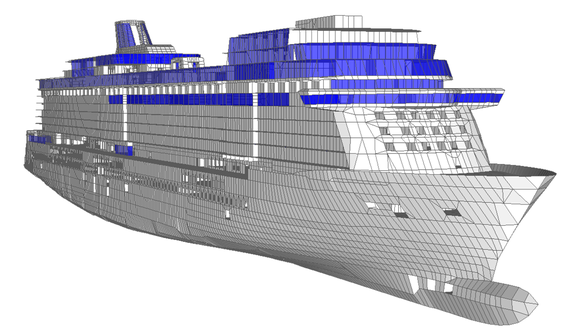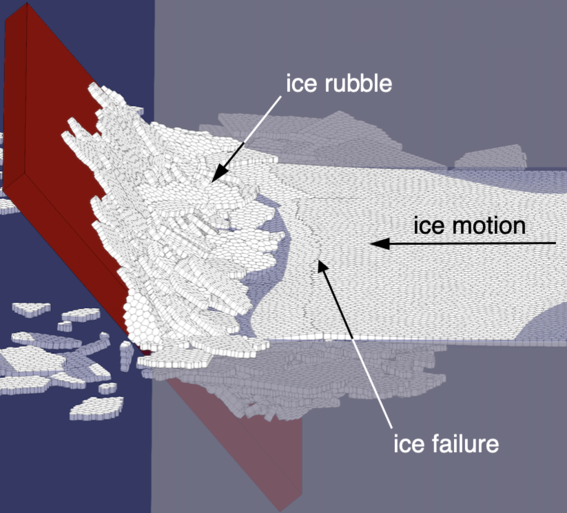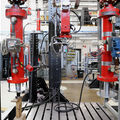Marine and Arctic Technology

We aim for radical creativity in future marine and arctic technology that can solve environmental challenges, improve operational efficiency, and assist in the sustainable use of the ocean. Our research focuses on marine structures, marine hydromechanics, marine system intelligence, and understanding of sea ice behavior and its impact on ships and offshore structures. Aalto Ice and Wave Tank, together with other novel research facilities, act as a platform for excellence in research, teaching, and societal impact in Finland and worldwide.
Our research applies first principles of solid and fluid mechanics to problems related especially to marine and arctic technology:
- The fluid mechanics research focuses on problems of open water with a free surface, hydroelasticity with strong fluid-structure and fluid-ice-structure interactions.
- Solid mechanics research focuses on the interaction between load, response, and strength, with the main applications on fatigue, ultimate, and accidental limit states in open sea and arctic operations.
Further, solid mechanics has a central role in our ice mechanics research. The complex applications we study require holistic risk- and experience-based designs with novel solutions.

Impact
Our unit is internationally highly recognized for its research and also societal and industrial impact. We undertake initiatives in research and focus on high-level scientific challenges with technological impact. We engage in both long- and short-term projects, enabling strategic developments and rapid actions related to the emerging needs of society.
The group has excellent international and national research networks, and we are active members of the Finnish Maritime Cluster, which has a strong position nationally and internationally.
We advance the development of our research fields by producing and transferring new knowledge to industry and society through teaching. Research and teaching are the primary duties of our unit, and societal impact occurs through them. The unit provides internationally recognized education, and we are the only university in Finland offering education related to Marine and Arctic technology.
Infrastructure
The basis of our research is extensive experimental research in full-scale and in laboratories. The group manages novel research infrastructure, the Aalto Ice and Wave Tank and the Solid Mechanics Laboratory. Based on the understanding of fundamental physics and experimental findings, we develop modeling techniques suitable for research and industrial needs.
Aalto Ice and Wave Tank
Aalto Ice and Wave Tank is a multipurpose basin ideally suited for testing ships and other maritime structures in ice conditions.

Solid Mechanics Laboratory (external link)
In the solid mechanics laboratory, we carry out data-driven experiments spanning length scales from micrometres to metres. Our core expertise is the characterization of material and structural deformation mechanisms.

Research topics
Our marine structures and solids mechanics research studies the mechanical behavior of high-strength materials, material systems, and structures. We also develop high-performing structures to meet the increasingly stricter requirements of society by considering the manufacturing quality produced at laboratory and industrial scales. We are focusing our research on structural load-carrying and failure mechanisms under different load scenarios, which occur in short and long terms. The load types are static, fatigue, extreme (ultimate), and impact loading. We do extensive experimental, theoretical, and computational studies across multiple length scales and fields of science to gain a deep understanding of materials and structures and to gain data for material and structure modelling, which is the other branch of our research work.
In our research, we use the latest numerical techniques, based on the finite element method (FEM) and homogenization, to gain insight into theoretical modeling and prevailing assumptions. We aim for simple but robust theoretical models to speed up the analysis and structural design processes. The development of these methods is motivated by the challenges of large, complex structures and short design cycles. Most of our research activities focus on high-strength materials, thin-plated and lattice-type sandwich structures, and wooden and other composite structures. In these areas, the focus is on how the materials’ microstructure and structural topology affect strength and stiffness and how non-linearities in load effects are transferred from the structural level toward component and material length scales. In particular, the interfaces between structural components, e.g., welded joints and tribological systems, are crucial to structural safety, and they are thus in a significant role in our research activities.
Key personnel
Our Arctic marine engineering and ice mechanics research has a strong focus on future sea ice and its behavior. Ice-covered seas are a harsh but sensitive environment that sets stringent requirements for safety and efficiency for all operations on them, yet global warming affects them by making sea ice thinner, warmer, and more fragmented. To understand these changes and their effects, we need to study how ice floes and waves interact with ships and offshore structures, and how warm ice deforms and fractures. Research on this requires multidisciplinary approach that reaches over scales. Our group combines expertise in ice and solid mechanics, mechanical and safety engineering, naval architecture, and risk management.
We also focus on mechanics of ice loading processes. Detailed insight on this is important for design of modern offshore structures and vessels operating on cold sea areas. For example, there is currently a strong drive towards offshore wind power, also on annually freezing sea areas. For the economic feasibility of these installations, we need new in-depth insight on dynamic ice-structure interaction, and on optimization of structures in ice. Closely related and active research area is ship-ice interaction, which is of crucial importance for understanding both the resistance of ships in ice and the ice-induced loads on ships.
The basis of our research is on rigorous laboratory and full-scale experimentation as well as novel numerical tools. In full-scale measurements, often performed onboard ships, emphasis is put on achieving simultaneous data on ice conditions and ice loads. In model scale, Aalto Ice and Wave tank has a central role in our experimental work and in validation of our numerical tools, which our group develops. Our simulations tools are based on three-dimensional discrete element method.
Key personnel
Our risks and intelligence in marine system research is focused on developing concepts, methods, tests, and frameworks for creating safe technological and socio-technological systems and managing associated risks. These advances in risk analysis and safety science are applied to specific problems in maritime and materials engineering. This serves society by increasing our understanding of how maritime and structural safety is created and maintained and how safety risks can be managed effectively.
Given the rapid developments in marine technologies, with increased automation, digitalization, and system integration, there is a constant need to ensure the safety of the design and operation of new maritime systems. Scenario-based risk modeling is essential for the safe operation of ships and maritime traffic systems. Advanced ships require new and improved designs and smart situation awareness, and decision support systems. To achieve this, our research focuses on the development of innovative ship designs accounting for efficient traffic management systems and navigation safety controls. Data mining, machine learning, and AI techniques are used to support intelligent decision-making. Besides high performance, the interpretability and transparency of these algorithms are investigated to build and deploy human-centered systems and solutions.
In the context of Arctic navigation, the current design regulations for ice-going ships and offshore structures fail to predict the actual safety and required safety level of the operations. Holistic risk analyses typically include the definition of hazard scenarios, their probability of occurrence and the severity of their consequences. Such an assessment is challenging for Arctic operations, as operational data is scarce. In this area, one of the goals is to apply similar methods to those developed for the safety of marine traffic in open waters – particularly the heavy tanker traffic in the Gulf of Finland – to ice-covered waters.
Key personnel
Personnel

















